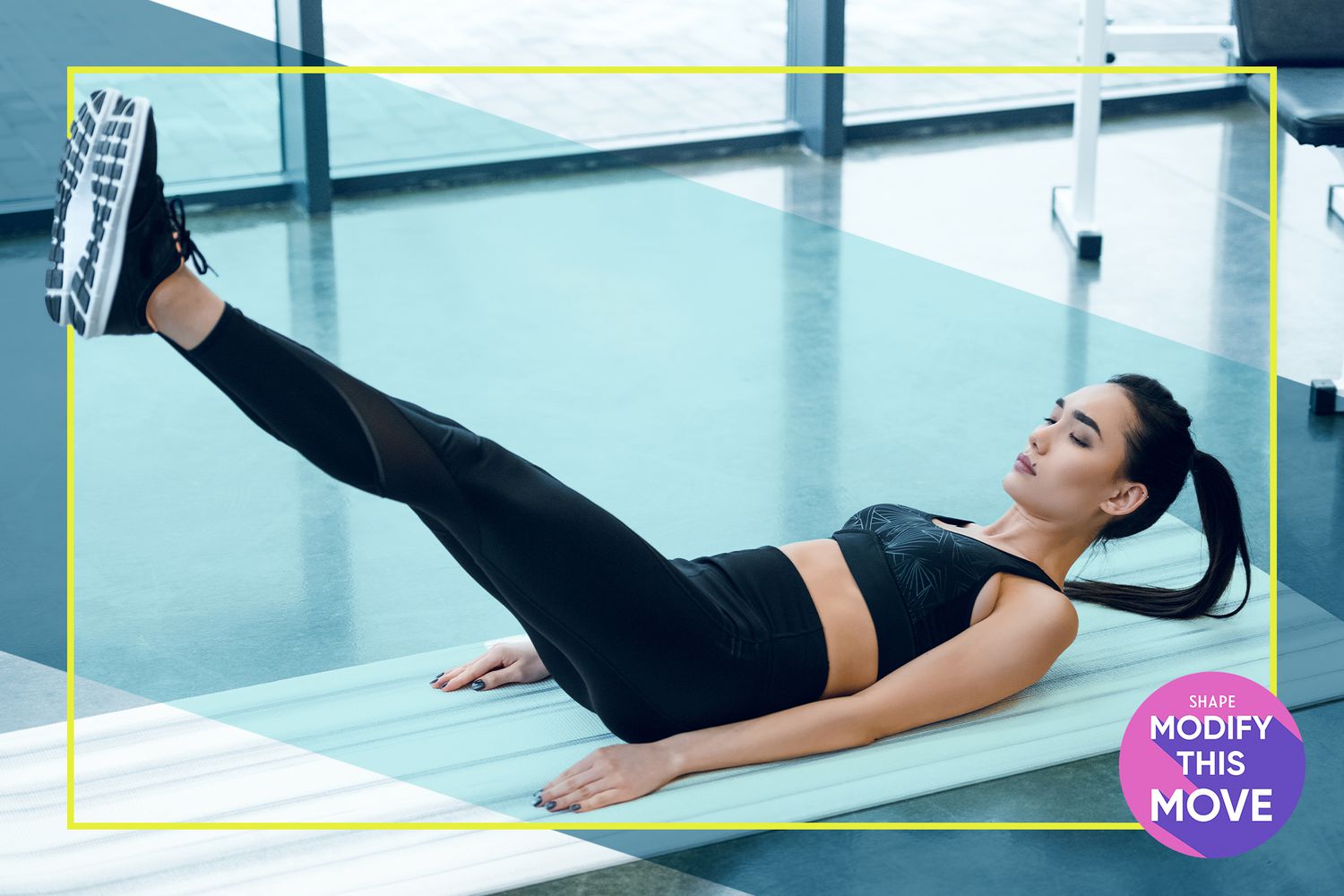Different variations of leg raises for all levels of fitness

Welcome to Modify This Move, the ongoing series where you'll find everything you need to amend a standard exercise to meet your goals, your body, and your mood. Each story breaks down how to perform a foundational fitness move, then offers various modifications based on your current fitness or energy level, present or prior injuries, or the muscles you want to target most. So check your ego at that door and ensure every workout meets you where you're at today.
Leg raises are an abdominal exercise that uses lumbar flexion to work the rectus abdominus. Lumbar flexion ab exercises, such as crunches, are performed by flexing your lower back (lumbar spine). Many people need help performing abdominal exercises that use lumbar flexion because they end up using their hip flexors instead of their abdominal muscles. Instead of flexing the lumbar spine, people tend to flex at the hips, which will not work the abdominals effectively. The abdominals attach at the ribcage and pelvis, and contracting them brings those attachments points toward each other. Without correctly using your abdominals, you will primarily work your hip flexors and a bit of the core stabilizer muscles, but you will also likely experience back pain.
Instead of simply curling up or lifting your upper body, you should think of contracting your ribcage toward your pelvis. To correct this, press your lower back into the floor (to remove the anterior tilt of your pelvis), tilting the top of your pelvis down (posteriorly) so there is no arch in your lower back, and it is in a neutral position. At this point, you should feel your abdominals engage. When you perform a leg raise from this modified position, think about bringing your belly button toward your chest using your abdominal muscles.
A. Lie on the floor or a bench with your legs straight. Tilt your pelvis so your lower back presses against the floor with little to no arch in your lower back. Extend your arms by your sides, palms up, or you can hold onto an anchor point behind your head.
B. Contract your core as if bracing for impact and squeeze your ribcage toward your pelvis (think about bringing your chest toward your belly button). Inhale.
C. Slowly lift your legs off the floor for a count of two while exhaling.
D. Stop once your legs are not quite parallel with the floor or when your lower back starts to come off the floor. Pause for one count.
E. Inhale while you lower your legs for a count of two.
It can be challenging to do a proper leg raise if you have an injury, experience back pain, or don't feel strong enough in your core. If the OG move feels a bit too tricky, don't be afraid to try a leg raise variation that will help you meet your individual needs and goals.
A. Place your feet flat on the floor in line with your hips, with your knees bent about 90 degrees.
B. Place your hands by your sides with your palms facing up.
C. Place your head on the floor and press your lower back into the floor.
D. Lift your knees so they are forming a straight right angle with the floor
E. Brace your core by squeezing your ribcage toward your pelvis and contracting as if expecting an impact to your abdomen.
F. Lower either both or one heel to the floor and stop an inch or two above the floor, then raise back up and repeat with the other leg if performing single leg version.
G. Ensure your back stays pressed to the floor, core engaged.
Tip: You can progress this version without doing full straight leg raises by reducing the bend in your knees over time.
The modified candlestick is a challenging leg lift variation that adds extra stimulus from thrusting the hips into the air and slowly controlling the descent of your hips and legs. The benefit comes from the lowering (eccentric) phase, so try to go as slow as possible during that part of the movement.
A. Lay on your back on a bench or the floor and grasp onto an anchor point behind your head. If using a bench, hold the end of the bench.
B. Contract your abdominals, crushing your ribs toward your pelvis, and ensure there is no arch in your lower back.
C. With straight knees, raise your legs first and then your glutes and hips off the bench to point them above you.
D. Lower your hips slowly, with control, resisting gravity as you bring them toward the bench or floor, then let your legs lower as slowly as you can, using your abdominals to prevent them from dropping.
Tip: Try bending your knees if the above version is too difficult. If you can do 10 this way, move on to the straight-leg version.
If you have pain or an injury that prevents you from doing leg raises, try the transverse abdominus (TVA) leg raise variation. This exercise is also used to help correct and heal from injuries and pain such as back pain, sports hernias, pelvic floor dysfunction, sacroiliac joint dysfunction, diastasis recti, or pelvic girdle pain.
The TVA leg raise helps engage the lower abdominals while simultaneously stabilizing the pelvis and lower back (lumbar spine) while you lift one bent leg at a time. It helps build stability and strength in the deep, transverse abdominus muscles and other connected musculature that help stabilize the spine.
It’s a movement frequently recommended to postpartum women who have issues with pelvic pain and diastasis recti, so long as they’ve been cleared for exercise. Always check with a healthcare provider before exercising if you have pain or injury.
A. Lay on the floor on your back with your knees bent. Place your hands on the front of your pelvis. Ensure your pelvis is tilted so your lower back is on the floor.
B. Engage the TVA by contracting enough to push your fingers upward.
C. Keep your core engaged and lift one bent leg off the floor until your hip is flexed 90 degrees.
D. Slowly lower your leg while keeping your core engaged. Repeat on the other leg.
Adding an isometric hold to your leg lifts provides an extra challenge, recruits more motor units to build muscle mass, and improves core stability.
A. Lie on the floor or a bench with straight legs, holding a weight plate or dumbbell. Tilt your pelvis so your lower back presses against the floor with little to no arch in your lower back.
B. Contract your core as if bracing for impact and squeeze your ribcage toward your pelvis. Inhale.
C. Lift the weight directly above your head and lock out your elbows. Lift your head and upper back off the floor.
D. Slowly lift your legs off the floor for a count of two while exhaling and maintaining the plate isohold overhead.
E. Stop once your legs are not quite parallel with the floor or when your lower back starts to come off the floor. Pause for one count.
F. Inhale while you lower your legs for a count of two.
Adding a band as resistance to your leg raise will increase the challenge and help you progress the movement in a new way.
A. Anchor a resistance band either looped around your feet or attached with ankle cuffs.
B. Lie on the floor or a bench with your legs straight and attached to the band.
C. Tilt your pelvis so your lower back presses against the floor with little to no arch in your lower back. Extend your arms by your sides, palms up, or you can hold onto an anchor point behind your head.
D. Contract your core as if bracing for impact and squeeze your ribcage toward your pelvis (think about bringing your chest toward your belly button). Inhale.
E. Slowly lift your legs off the floor against the band's resistance while exhaling.
F. Stop once your legs are not quite parallel with the floor or when your lower back starts to come off the floor. Pause for one count.
G. Inhale while you lower your legs, resisting the band's pull for a count of two.




